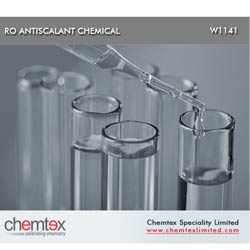Scale and Corrosion is considered a curse to all industries, be it large or small.
Due to their subjection to water systems, heavy metal installations, industries face a huge annual loss due to these complications as they have direct implications on the production rate and outcome. Formation of scales cause severe metal lining problems, decrease in fluid flow rate, pitting and perforation, pore throats, wear and tear, machinery failure and primarily first stage of corrosion (in most cases).
Antiscalant dosing is preferred over other conventional treatments in counteracting scaling and corrosion. The primary reason being its simplicity and effectiveness over particulate matter deposition and cost efficiency. Most antiscalant chemicals work on adsorption mechanism, where they get adhered to the surface, preventing any interaction between inorganic salts and surface lining, ensuring lesser accumulation, lesser precipitation in the feeding solution, and ensuring prolonged protection.
Chemtex Antiscalant Chemicals can be directly dosed into the feeding system, and reduces the usage of acid usage. The exact dosage rate varies depending upon the severity of scaling, and typical OEM recommendations.
The composition and physico-chemical nature is tailor made to suit the specific nature of the problem enquired. Depending upon a number of co-related factors that help improve the workability of the system, also inhibiting the accumulation of inorganic salts that forms scales. Common compounds that are used in formulating an antiscalant are polyacrylic acids, polymaleic acids, organophosphates, polyphosphates, phosphonates, anionic polymers, etc.
The most likely mineral contaminants that poses threat to any metallic system are Calcium carbonate, Calcium sulphate, Strontium sulphate, and Barium sulphate.
- Boiler Antiscalants are multi-purpose heavy-duty chemicals designed to remove rust, hard deposits of water scale, iron oxides, oily contaminants, lime and greasy deposits from boiler systems. Regular usage of these chemicals provide protection to system metallurgy, ensuring an optimally longer boiler life cycle.
- For Reverse Osmosis systems, various formulations were evolved depending upon the type of membrane, quality of feed water and rate of product recovery;
- Use of high pH RO antiscalants to inhibit scales and disperse colloidal particles in cellulose acetate and thin-film membrane separation systems, stable over a wide range of supersaturated salt solution. It prevents precipitation on the membrane surface, reducing the risk of scaling and helping in effective plant operations with optimal recovery rate.
- Neutral RO antiscalants reduces membrane fouling within separation systems, effectively controlling inorganic salts, metal hydroxides, and colloids in RO feed water
- Application with low pH antiscalants eliminate inorganic scales in multiple applications areas. It stabilizes metal ions to prevent metal oxides precipitation and disperses silt and clay particles.
- Thermal Desalination Antiscalant, new formulation is precisely formulated in order to provide excellent control of scaling & fouling. On regular application, it ensures reduced cleaning frequency and thorough cleaning.
General Key Features & Benefits:
- Excellent cleaning efficacy
- Wetting agent for scale penetration
- Excellent removal of oil and grease
- Inhibitor package to prevent corrosion
- Excellent de-rusting
Chemtex Speciality Limited manufactures a wide range of antiscalant chemicals used for the purpose of deterrence of scaling and elimination of inorganic deposits over a broad spectrum application.
For more information, please visit: www.water-chemicals.com







